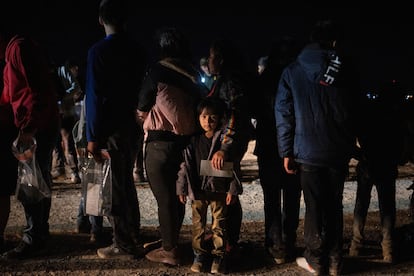Immigration crisis: Illegal border crossings into US hit record highs
Border authorities registered more than 239,000 encounters in May, as a growing number of migrants from Cuba, Venezuela and Nicaragua, as well as Russia and Ukraine, sought to enter the country


More than 239,000 migrant encounters were registered at the US-Mexico border in May, setting a new record high for illegal crossings. The number surpasses the previous record set in March 2020, when 220,000 were registered. Encounter numbers refer to events, not individuals; a single person trying to cross the border can be caught, expelled and then repeat the attempt multiple times, each of which would count as a new expulsion.
The May figure represents a 2% rise compared to April – an uptick attributed to an influx of migrants from Cuba, Venezuela, Nicaragua, as well as Russia and Ukraine due to the war in Ukraine.
Border Patrol authorities arrested 177,000 people at the border, 15% more than in April. More than 60,000 of the individuals had attempted a previous crossing before. The government has attributed the spike to Title 42, a controversial immigration policy introduced under the Trump administration that allows US border officials to deport certain migrants without court hearings. The provision was introduced at the beginning of the coronavirus pandemic on the grounds that immigration flows posed a public health problem.
“The large number of expulsions during the pandemic has contributed to a higher-than-usual number of migrants making multiple border crossing attempts,” US Customs and Border Protection (CBP) stated in a press release on Wednesday.
The government of US President Joe Biden tried to end Title 42, but was blocked by a US court. The move to lift the measure has been met with criticism from the Republican Party, as well as some Democrats, who fear the crisis will sway voters ahead of the November midterm elections.
But while there has been a lot of debate about ending the policy, US border regulations has remained unchanged. “Current restrictions at the US border have not changed: single adults and families encountered at the Southwest Border will continue to be expelled,” said CBP Commissioner Chris Magnus in a press release.
With temperatures rising ahead of summer, Magnus warned migrants not to make the crossing. “The terrain along the Southwest Border is extreme, the summer heat is severe, and the miles of desert that migrants must hike after crossing the border are unforgiving,” he said. “Our message to those who would try and gain illegal entry to the United States remains the same – don’t make the dangerous journey only to be sent back.”
Border crossings of unaccompanied children along the southwest land border increased 21%, with 14,699 encounters in May compared with 12,180 in April. The number of families who attempted the crossing also rose 8% from 55,092 in April to 59,282 in May. This figure, however, has been steadily falling since the peak of 86,631 in August 2021.
Most of the border crossings recorded were made by individuals. According to the CBP, of the 239,416 encounters registered, 25% involved individuals who had at least one prior crossing attempt in the previous 12 months. Forty-two percent of encounters were processed for expulsion under Title 42.

US Secretary of Homeland Security Alejandro Mayorkas warned about the immigration crisis at the US-Mexico border at the end of April. In a memorandum, he stated that there are currently more people in the world displaced from their homes than at any time since World War II. The global trend is having a particularly big impact on the United States. In April, CBP encountered an average of over 7,800 migrants per day across the southwest border, compared to 1,600 per day before the pandemic, Mayorkas said.
The Secretary of Homeland Security also noted that “migrants from Cuba, Venezuela and Nicaragua have steadily increased, accounting for 37% of FY 2022 [from October 2021 to October 2022] non-Mexican encounters.” Between 2014-2019, these nationalities accounted for just 8%.
In May, Border Control agents apprehended more than 18,900 Nicaraguans, a record high. This is double the number of Salvadorans apprehended at the border. Nearly 19,000 Colombian were also caught, a rise of 45% since May 2020, when just 400 Colombians were apprehended.
The war in Ukraine has also led hundreds of Ukrainians and Russians to seek entry to the United States via Mexico. This has forced the Biden administration to implement a program that allows these migrants to start the legal migration process before leaving Europe. The measure is aimed at relieving pressure at immigration camps in Mexico, which have been overwhelmed by the arrival of migrants from Central America and Haiti.
The May figures were released just days after the Summit of the Americas, where 20 countries in the region signed the Los Angeles Declaration on Migration and Protection. This document seeks to create a regional system to address the crisis on the continent. Over six million Venezuelans have fled the country, making it the second-worst displacement crisis in the world. Eighty percent of this diaspora is spread over 17 Latin American countries, but principally Colombia and Peru, which are home to 1.8 million and 1.3 million Venezuelans respectively. Meanwhile, 150,000 Nicaraguans have fled Daniel Ortega’s dictatorship to Costa Rica, which has a population of just five million.
Tu suscripción se está usando en otro dispositivo
¿Quieres añadir otro usuario a tu suscripción?
Si continúas leyendo en este dispositivo, no se podrá leer en el otro.
FlechaTu suscripción se está usando en otro dispositivo y solo puedes acceder a EL PAÍS desde un dispositivo a la vez.
Si quieres compartir tu cuenta, cambia tu suscripción a la modalidad Premium, así podrás añadir otro usuario. Cada uno accederá con su propia cuenta de email, lo que os permitirá personalizar vuestra experiencia en EL PAÍS.
¿Tienes una suscripción de empresa? Accede aquí para contratar más cuentas.
En el caso de no saber quién está usando tu cuenta, te recomendamos cambiar tu contraseña aquí.
Si decides continuar compartiendo tu cuenta, este mensaje se mostrará en tu dispositivo y en el de la otra persona que está usando tu cuenta de forma indefinida, afectando a tu experiencia de lectura. Puedes consultar aquí los términos y condiciones de la suscripción digital.
More information
Archived In
Últimas noticias
Sydney Sweeney, the actress praised by Trump: ‘Women are up against what society wants them to be’
The Bolsonaro surname: An advantage or liability in Brazil’s 2026 presidential elections?
Raúl Rocha, from jet-setting with Miss Universe to arms trafficking and fuel theft
80,000 barrels of Mexican oil sent to Cuba: Havana drawn into the US–Mexico clash
Most viewed
- Reinhard Genzel, Nobel laureate in physics: ‘One-minute videos will never give you the truth’
- Pablo Escobar’s hippos: A serious environmental problem, 40 years on
- Charles Dubouloz, mountaineering star, retires at 36 with a farewell tour inspired by Walter Bonatti
- Why we lost the habit of sleeping in two segments and how that changed our sense of time
- The fall of a prolific science journal exposes the billion-dollar profits of scientific publishing










































